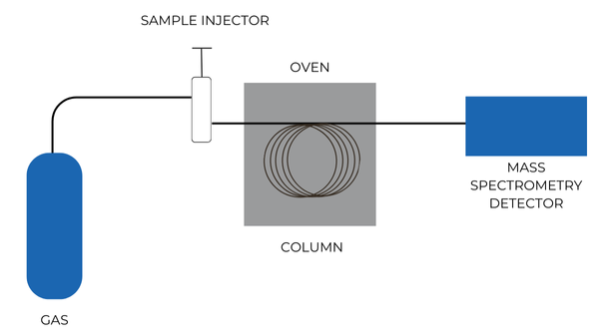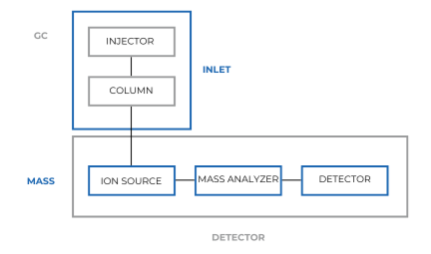Gas Chromatography Mass Spectrometry (GC-MS)
What is Gas Chromatography Mass Spectrometry?
Gas Chromatography Mass Spectrometry (GC-MS) is an analytical technique that combines two powerful chromatography instruments: gas chromatography (GC) and mass spectrometry (MS). These instruments are used to analyze compounds in complex chemical mixtures.
During research Mass spectrometry acts as a detector, helping to identify and quantify compounds that have been previously vaporized and separated by gas chromatography (GC). Gas chromatography provides researchers with data on retention time while mass spectrometry contributes additional information known as mass data. Having this mass data is crucial for identifying, quantifying, and understanding the structural and chemical properties of molecules in a sample.
The key advantage of GC-MS analysis is its ability to provide multidimensional data. This allows for both qualitative and quantitative insights. Another advantage of mass spectrometry is that it is capable of detecting compounds at very low concentrations. This makes it the preferred method for regulatory compliance and quality control procedures.
What are the processes that occur in a mass spectrometer ?
Why is there a vacuum in a mass spectrometer?
The mass spectrometer’s vacuum system plays a crucial role in contributing to the overall performance analysis. Here are a few keyways in which it does so.
Facilitating ion flight: In mass spectrometry, the vacuum creates an environment where ions can travel freely without colliding with air molecules or other gas particles. This unrestrained travel is essential for accurately determining the ions’ mass-to-charge ratios (m/z)
Minimizing signal loss: By reducing the number of gas molecules present, the vacuum minimizes collisions between ions and background gas species. It also creates a chemically clean environment, reducing the risk of ions reacting with residual gas species. Also minimizes unwanted signals that could interfere with the detection of analyte ions.
Preventing electrical arcing: The vacuum enables components to function at high electric potentials without causing electrical arcing. This is crucial for elements like electrostatic lenses and quadrupoles that need substantial potential differences.
Enhancing sensitivity and detection limits: The vacuum environment improves the instrument’s ability to detect and measure even small quantities of analytes. Some ionization methods, like electron impact ionization, require a high vacuum to function effectively.
Maintaining instrument cleanliness: The vacuum helps prevent contamination of the instrument’s internal components, which is crucial for long-term performance and reliability.
Gas Chromatography Mass Spectrometry Sample Preparation:
We offer several sample preparation guides to assist you when selecting the appropriate sample preparation technique. Selecting the correct technique is crucial for achieving accurate and reliable analytical results.
The primary objectives of sample preparation include:
- Cleaning the Sample: Removing impurities that could interfere with the analysis.
- Concentrating the Target Analyte: Increasing the detectability of the analyte.
- Modifying the Sample Matrix or Solvent: Ensuring compatibility with the chosen analytical method.
- Derivatizing the Analyte: Enhancing the analyte’s detectability and stability.
To learn more make sure to read this technical note – Click to view
SCION Mass Spectrometry Instruments
Our mass spectrometry instruments offer both precision and efficiency to meet the needs of modern, high-throughput analytical laboratories. The SCION 8700 Single Quadrupole MS and the 8900 Triple Quadrupole MS, are both designed to integrate effortlessly with SCION’s gas chromatography (GC) instruments. Our systems deliver exceptional performance, reliability, and productivity, making them ideal for laboratories with demanding analytical workflows.
The SCION 8700 Single Quad (SQ) MS is a versatile and robust mass spectrometer that excels in routine applications requiring high sensitivity and reliability. Its user-friendly nature and cost-effectiveness make it a preferred solution for both targeted and untargeted analyses in fields like environmental monitoring, food safety, and quality control. The SCION 8700 provides accurate mass filtering and quantification with minimal maintenance, ensuring consistent results even in fast-paced laboratories.
The SCION 8900 Triple Quad MS is designed for more complex and rigorous analyses. This advanced system offers unparalleled selectivity and sensitivity, in applications where trace-level detection and quantification are critical. With its ability to perform Multiple Reaction Monitoring (MRM), the 8900 TQ-MS is ideal for applications requiring precise quantification of low-abundance compounds in complex matrices, such as pharmaceuticals, forensics, and toxicology. With a fast MRM scan speed of 1,000 MRM/sec, the 8900 TQ-MS is an excellent tool for analyzing hundreds of pesticides in a single run.
Gas Chromatography Mass Spectrometry Applications:
Environmental Monitoring
GC-MS is extensively used in environmental monitoring to detect and quantify pollutants in air, water, and soil. This chromatography technique is highly effective for identifying volatile organic compounds (VOCs), semi-volatile organic compounds (SVOCs), pesticide residues, and persistent organic pollutants (POPs).
Below are several application notes demonstrating our use of the SCION gas chromatography instruments, as well as the SCION mass spectrometry instruments, to conduct environmental analysis testing.
Determination of Polychlorinated Biphenyls (PCBs) in water using GC-SQMS
Plant Protection Products Impurity Screening by GC-FID with GC-MS Confirmation
Multiplexed pesticide analysis by GC-TQMS
Food Industry
In the food industry, Gas Chromatography-Mass Spectrometry (GC-MS) is used to monitor contaminants in food products. It analyzes the composition of foods and beverages by identifying flavour and aroma compounds that contribute to their sensory profiles. Because of this GC-MS helps assess ingredient quality, detect adulteration, and analyze fatty acid composition. Thus supporting food safety and quality assurance.
Below, we provide several application notes that demonstrate how we utilize our gas chromatography and mass spectrometry instruments for various types of food analysis.
Determination of Free Glycerol in Fatty Acid Methyl Esters and Biodiesel according to EN-14106
Flavour and Aroma Profile of Hops Using FET-Headspace on the SCION Instruments Versa using GC-MS
Determination of Hexanal in Foods Utilizing Dynamic Headspace GC/MS
Determination of Furan in Coffee by Static and Dynamic Headspace/GC/MS
Pharmaceutical Industry
GC-MS instruments are extremely useful in pharmaceutical research. Playing a critical role in various applications, including chemical and biological synthesis, analyzing drug components, and quantifying active pharmaceutical ingredients (APIs). The GC-MS analysis enables comprehensive preliminary drug screening and quality control.
Below, we provided an application notes that demonstrate how we utilize our gas chromatography and mass spectrometry instruments in pharmaceutical analysis.
Active Pharmaceutical Ingredients Qualitative Analysis by GC-MS
Chemical Industry
Our GC-MS solutions ensure adherence to standardized methods, offering clients reliable results and product specification compliance. Each solution is meticulously designed to address the unique demands of the chemical industry.
Below, we provide several application notes that demonstrate how we utilize our gas chromatography and mass spectrometry instruments for these types of analyses.
Import and Export of Chemicals EU/UK REACH Substance Identity Requirements
Headspace Assay of Polymers used in the Automotive Industry with an HT3 Dynamic Headspace Instrument
GC-MS Enquiry Form


